Introduction
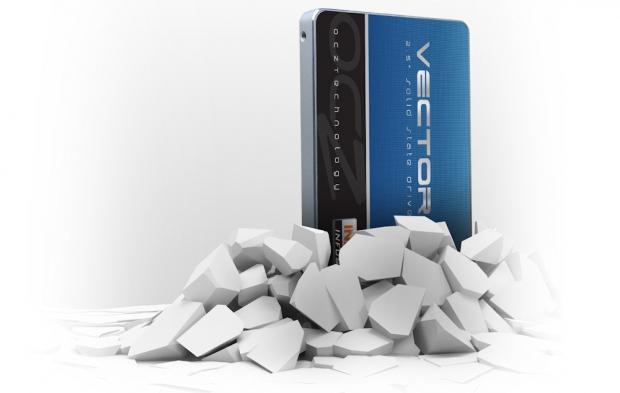
The holidays are over, hopefully you and your wallet made it through OK. Most high technology friends don't receive too many packages to unwrap since our wish list is made from a lot of exotic, far from mainstream items. If your loved ones didn't ask for a specific URL then the chances are good you received a few cards full of cash. So, what does everyone want to spend their Xmas loot on this year? A Ducati 1199 R, of course. Second on that list is a new high capacity, ultra performing SSD.
High capacity SSDs are coming into their own right now. In the past reaching for the highest capacity size meant compromising performance for large capacity. Running a 480GB SSD meant living with reduced 4K performance when compared to the 240GB models. The introduction of Vertex 4 changed the trend and 512GB became the true flagship in both capacity and performance.
Vector builds on the foundation laid by Vertex 4 and once again we have a full capacity drive with its full performance capability intact. Let's take a look!
Specifications, Pricing and Availability

Vector is OCZ's flagship consumer SSD. OCZ released this drive in three capacity sizes - 128GB, 256GB and the model we're looking at today, 512GB. We've already reviewed the two lower capacity drives and found they both delivered best of capacity size performance when compared to every other SSD we've tested. The 512GB shares the same on paper specifications with the 256GB. The 128GB model loses 130MB/s sequential write speed and around 10K read IOPS. Even with the reduced performance, we found the 128GB to be smoking fast.
In the two largest capacity sizes Vector is a beast of a drive delivering 550MB/s sequential read performance and 530MB/s sequential write. OCZ is still focusing on high IOPS performance and Vector delivers 100K read and 95K write IOPS.
We haven't observed a lot of price variation since Vector released a couple of months ago. The 128GB still holds a price of $159.99 at Newegg. The 256GB model moved from $289.99 to $269.99, a 7% decrease. The model we're looking at today, Vector 512GB is still $569.99 at Newegg. Certainly the 512GB model would look a lot more attractive at $1 per GB, but with Vector being the one of the fastest drives on the market today, there isn't a compelling reason for OCZ to reel in the price. We already have a few drives in hand that launch at CES 2013 and nothing from that stack is ready to take on Vector for the performance crown.
OCZ ships Vector with a five year warranty, desktop adapter bracket, screws and Acronis True Image data migration software.
Packaging
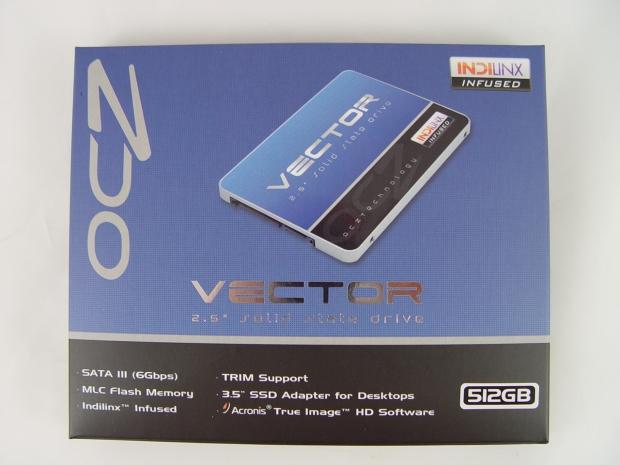
As with other OCZ products, the Vector family shares the same package design. The capacity size listed on the front of the package changes, but that's the only difference between the capacity sizes.

OCZ gives a lot of general information about their drive on the back of the package, but they don't list performance specifications. There is a good reason for that since OCZ has a long history of tweaking firmware during the lifecycle to increase performance.

Everything is packed well inside with the actual drive surrounded by foam and away from any accessories that could scratch the drive.

Here we see the accessory package all laid out. You get a desktop adapter in the package, screws, a sticker, a couple of paper manuals and on one of the manuals is a key code for Acronis True Image. You have to download the software from OCZ's website.
OCZ Vector 512GB SSD

Here we see the actual drive. The silver foil makes it a bit difficult to take a picture of and the image looks a bit dull. The drive is actually vibrant in color when in your hand.
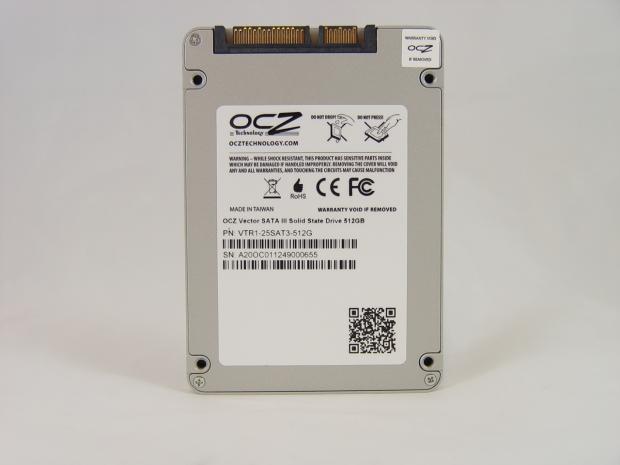
All of the data, serial number, model number and so on is located on the back of the drive.

Vector is a 7mm z-height drive so it works in notebooks, desktops and new ultrabooks that require the 7mm standard. All of the mounting points are the same as 9.5mm height drives so you're not going to run into any incompatibility issues.
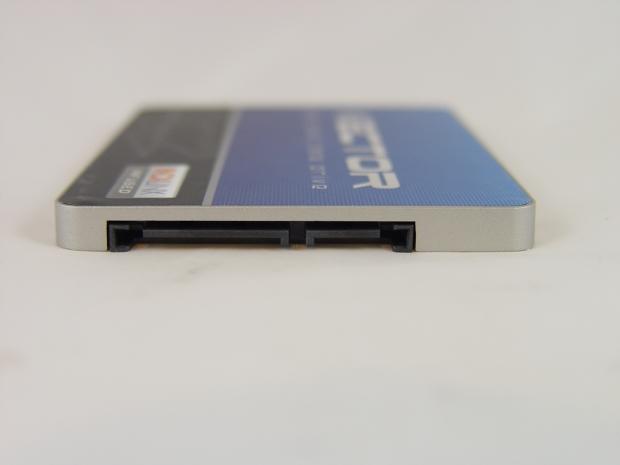
Vector also returns OCZ's flagship SSDs to an all-metal case. Late run Vertex 3 and all Vertex 4 drives mixed metal with plastic and the drives felt cheap. Vector is all-metal with a nice solid feel, the feel of quality.

This part is a bit exciting for me. The first time we tested a Vector product we didn't know what OCZ planned for the open DRAM pad on the PCB, seen here next to the Micron DRAM chip. OCZ configured the 512GB with the same 1GB size DRAM buffer found on the 256GB model. We speculated that OCZ might try to fit 1.5GB of DRAM on the 512GB drive, but that didn't happen.

With the Indilinx Barefoot 3 controller nestled in the middle on the other side, all of the flash surrounds the controller. There are 16 25nm IMFT flash chips with 8 on each side. Two Micron DRAM chips cache page table data.
Benchmarks - Test System Setup and ATTO Baseline Performance
Desktop Test System
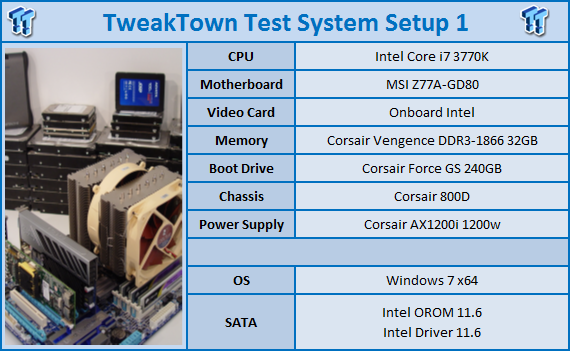
Lenovo W530 - Mobile Workstation
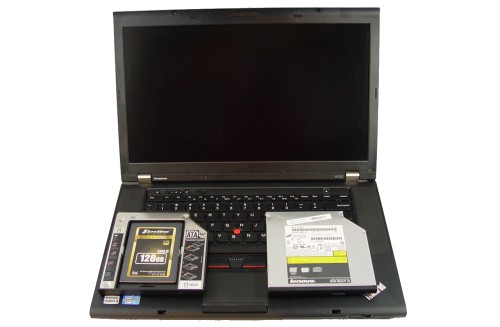
We use two systems for SSD testing. The desktop runs a majority of the tests and the Lenovo W530 runs the notebook power tests as well as the real-world file transfer benchmark.
ATTO Baseline Performance
Version and / or Patch Used: 2.34
ATTO is used by many disk manufacturers to determine the read and write speeds that will be presented to customers.
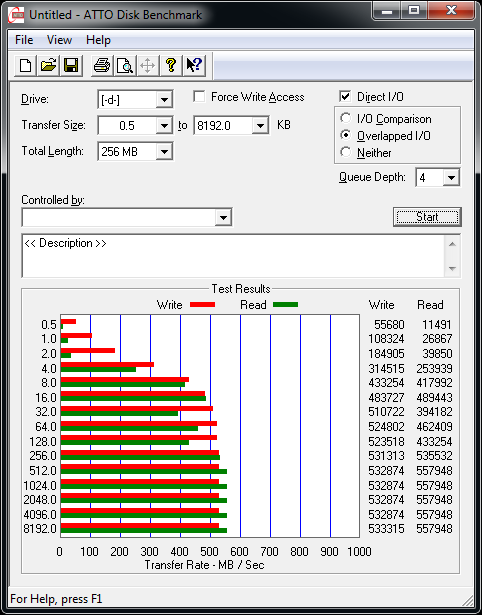
Using ATTO we get to see the marketing performance, the best case scenario. A lot of manufacturers moved to running this test at a queue depth of ten, but we still use the default QD4 setting. Even with this setting we still managed to outperform OCZ's marketing numbers by a small margin. Our results show read performance at 558MB/s and write performance at just over 533MB/s.
Benchmarks - Sequential Performance
HD Tune Pro
Version and / or Patch Used: 4.00
Developer Homepage: http://www.efdsoftware.com
Product Homepage: http://www.hdtune.com
HD Tune is a Hard Disk utility which has the following functions:
Benchmark: measures the performance
Info: shows detailed information
Health: checks the health status by using SMART
Error Scan: scans the surface for errors
Temperature display
HD Tune Pro gives us accurate read, write and access time results and for the last couple of years has been gaining popularity amongst reviewers. It is now considered a must have application for storage device testing.
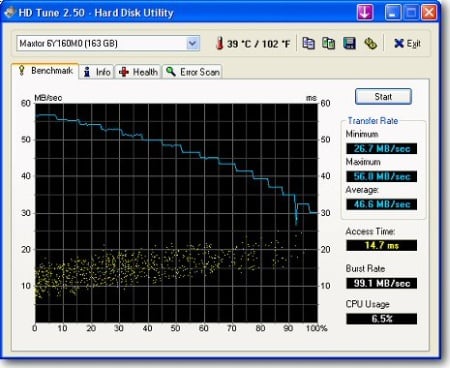

Just when you thought we could get down to the benchmarks without a bunch of text to read we hit a snag. In this test data is read across the drive at QD1. Vector, like Vertex 4 before it has a built in mechanism that limits read performance per request. So, while you can only read at around 350MB/s per request, you have bandwidth available to do another task without your system feeling slow or bogged down by the first task. The end result gives your computer a snappy feel even if you're running background tasks and multitasking.
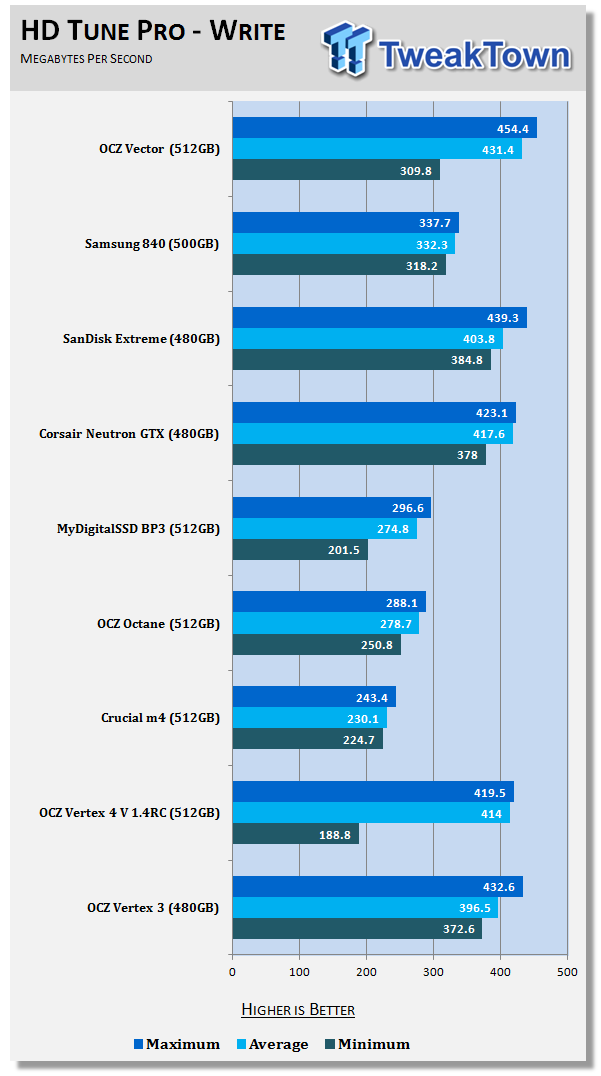
Performance and Storage Mode are also carried over from Vertex 4, but the 512GB Vector didn't get into storage mode in HD Tune Pro or HD Tach when we started our tests.
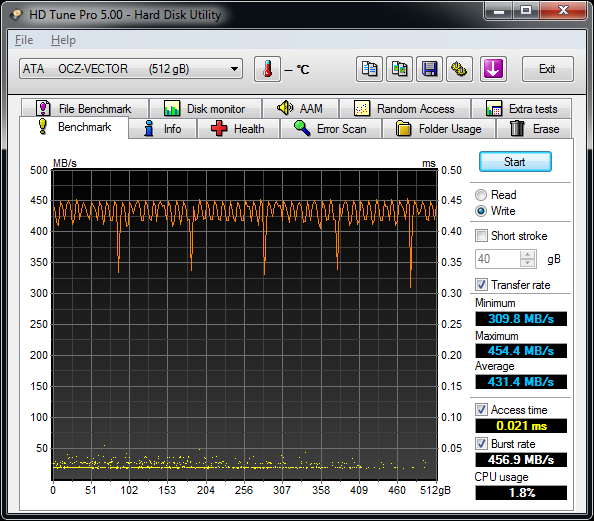
We were able to force the 512GB drive into storage mode after we hammered the drive with other tests, but in our initial runs (shown above) storage mode didn't kick in.
Benchmarks - AIDA64 Random Access Time
AIDA64 Random Access Time
Version and / or Patch Used: 1.60
Developer Homepage: http://www.aida64.com
Product Homepage: http://www.aida64.com
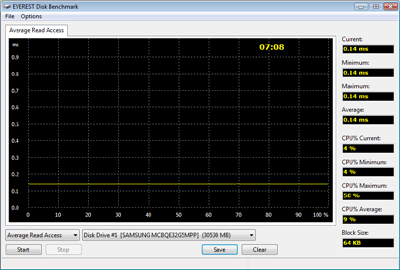
AIDA64 offers several different benchmarks for testing and optimizing your system or network. The Random Access test is one of very few if not only that will measure hard drives random access times in hundredths of milliseconds as oppose to tens of milliseconds.
Drives with only one or two tests displayed in the write test mean that they have failed the test and their Maximum and possibly their Average Scores were very high after the cache fills. This usually happens only with controllers manufactured by JMicron and Toshiba.
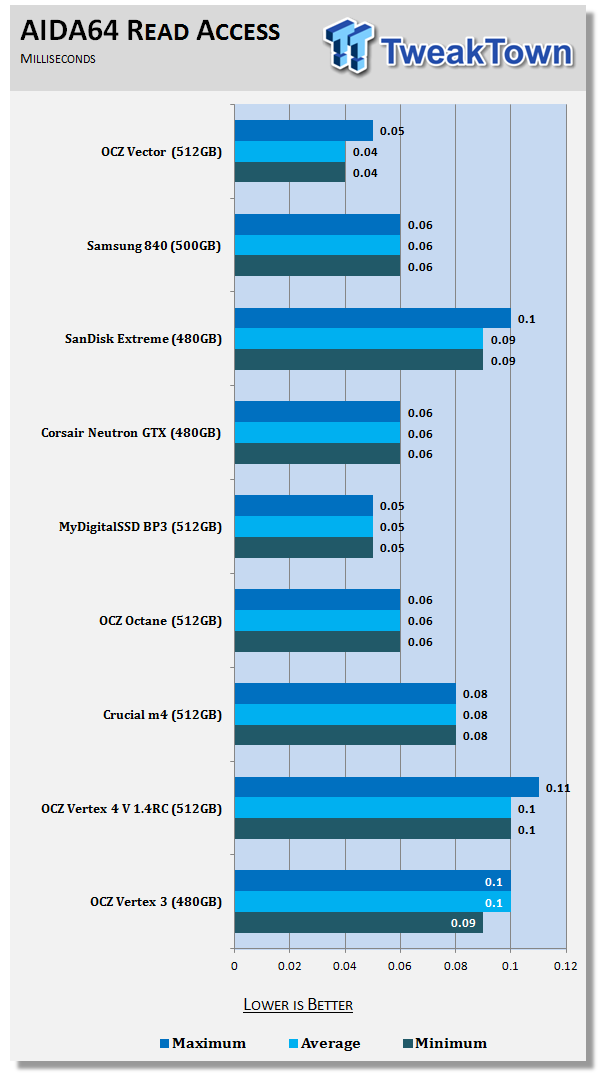
Vector has the lowest read access time of every other large capacity drive on our chart today.
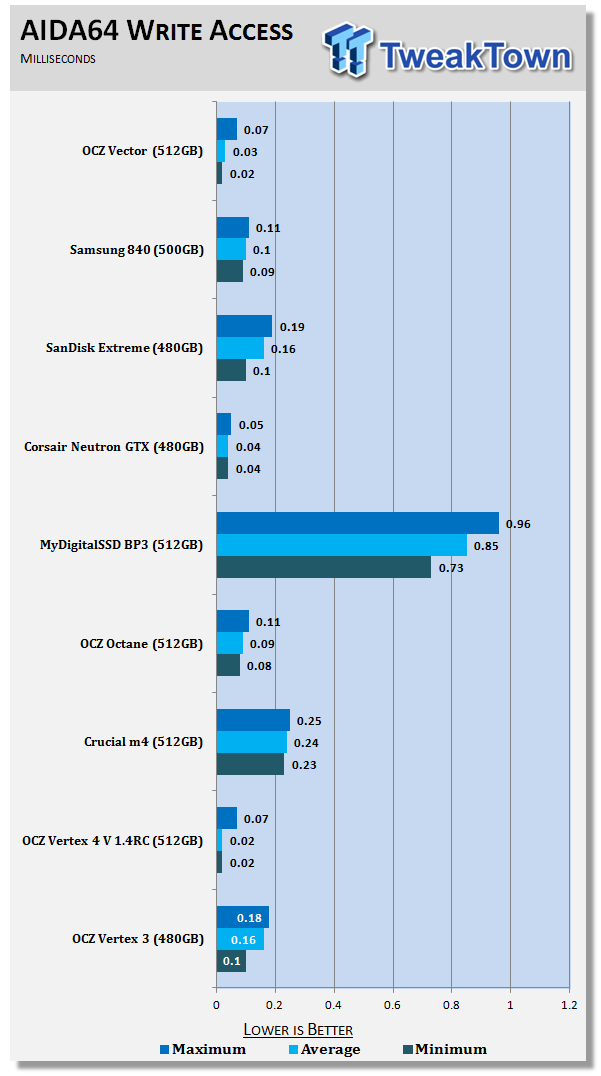
The write latency is also very low, but there was a spike around the 70% mark. The spike is very brief and shows in the results every time we run this test.
Benchmarks - Anvil Storage Utilities
Anvil Storage Utilities
Version and / or Patch Used: RC5
So what is Anvil Storage Utilities? First of all, it's a storage benchmark for SSDs and HDDs where you can check and monitor your performance. The Standard Storage Benchmark performs a series of tests, you can run a full test or just the read or the write test or you can run a single test, i.e. 4K DQ16.
Anvil Storage Utilities is not officially available yet but we've been playing with the beta for several months now. The author, Anvil on several international forums has been updating the software steadily and is adding new features every couple of months.
The software is used several different ways and to show different aspects for each drive. We've chosen to use this software to show the performance of a drive with two different data sets. The first is with compressible data and the second data set is incompressible data. Several users have requested this data in our SSD reviews.
Fill Compressible Data

Incompressible Data

The OCZ Vector 512GB doesn't offer different performance when changing from compressible to incompressible data.
Scaling Read IOPS through Queue Depth
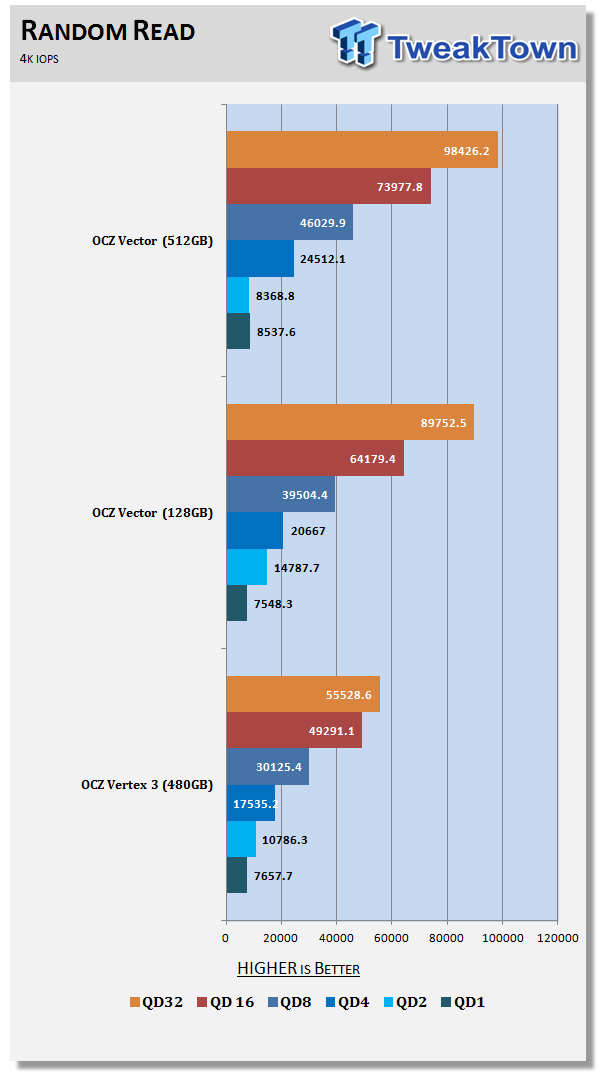
Scaling Write IOPS through Queue Depth
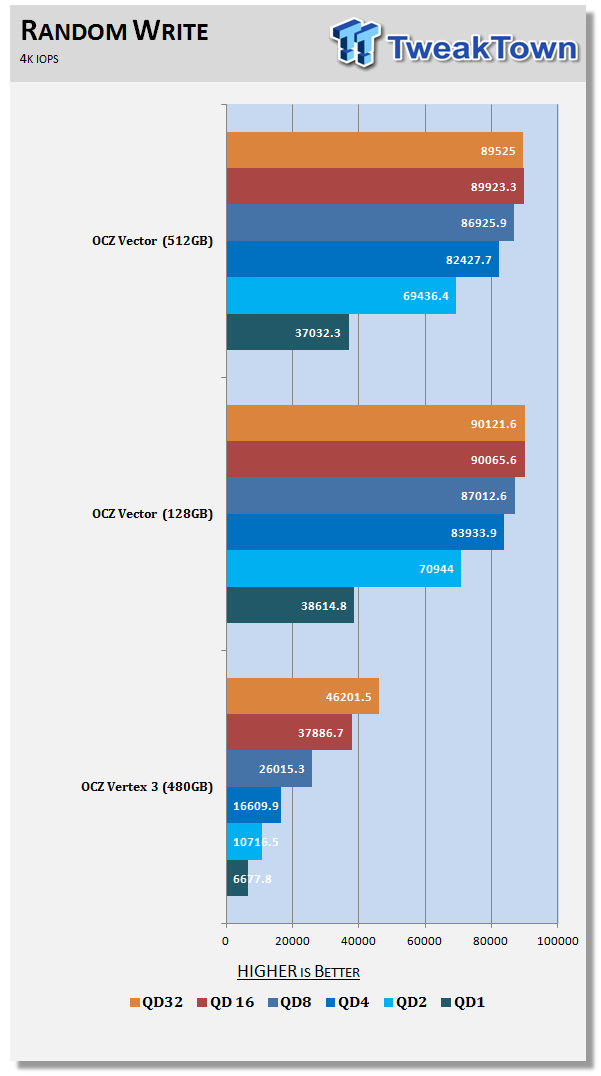
We're still working on running all of our sample drives through the new random IOPS tests, but I pulled a couple more drives in to make a couple of points. When companies market IOPS performance they like to show their big numbers, so high queue depth performance. In the real world, desktop computers rarely high queue depths over 8 so it's important to see low queue depth IOPS performance.
In these two charts we see Vector 512GB and 128GB against Vertex 3, a LSI SandForce based drive. These tests use compressible data so the Vertex 3 is running with a best case scenario. Right out of the gate and in the rest of the tests with the queue depth scaling, Vector walks away from the older drive.
Benchmarks - CrystalDiskMark
CrystalDiskMark
Version and / or Patch Used: 3.0 Technical Preview
Developer Homepage: http://crystalmark.info
Product Homepage: http://crystalmark.info/software/CrystalDiskMark/index-e.html
Download here: http://crystaldew.info/category/software/crystaldiskmark
CrystalDiskMark is a disk benchmark software that allows us to benchmark 4K and 4K queue depths with accuracy.
Key Features:-
* Sequential reads/writes
* Random 4KB/512KB reads/writes
* Text copy
* Change dialog design
* internationalization (i18n)
Note: Crystal Disk Mark 3.0 Technical Preview was used for these tests since it offers the ability to measure native command queuing at 4 and 32.

OCZ's Vector 512GB delivers 35MB/s of 4K single queue depth performance and that increases to nearly 100MB/s at QD4. From there Vector just takes off and shows why it's the current king of SSDs, over 400MB/s at QD32 when reading data.

Vertex 4 started us down a path of blistering 4K write performance, but Vector improves upon the previous Indilinx Infused drive by more than 12MB/s at 4K QD1. Vector 512GB scales nicely all the way to QD32, Vertex 4 dropped off between 4 and 32 depth.
This test also uses incompressible data, the same data that bring Vertex 3 down quite a bit. Here we can see why OCZ started down its own path and acquired Indilinx and a chunk of PLX. Larger drives are the future and LSI SandForce's current offering doesn't perform well when working with high capacity sizes.
Benchmarks - PCMark Vantage Hard Disk Tests
PCMark Vantage - Hard Disk Tests
Version and / or Patch Used: 1.0.0
Developer Homepage: http://www.futuremark.com
Product Homepage: http://www.futuremark.com/benchmarks/pcmark-vantage/

PCMark Vantage is the first objective hardware performance benchmark for PCs running 32 and 64 bit versions of Microsoft Windows Vista. PCMark Vantage is perfectly suited for benchmarking any type of Microsoft Windows Vista PC from multimedia home entertainment systems and laptops to dedicated workstations and high-end gaming rigs. Regardless of whether the benchmarker is an artist or an IT Professional, PCMark Vantage shows the user where their system soars or falls flat, and how to get the most performance possible out of their hardware. PCMark Vantage is easy enough for even the most casual enthusiast to use yet supports in-depth, professional industry grade testing.
FutureMark has developed a good set of hard disk tests for their PCMark Vantage Suite. Windows users can count on Vantage to show them how a drive will perform in normal day to day usage scenarios. For most users these are the tests that matter since many of the old hat ways to measure performance have become ineffective to measure true Windows performance.

HDD1 - Windows Defender
HDD2 - Gaming
HDD3 - Windows Photo Gallery
HDD4 - Vista Startup
HDD5 - Windows Movie Maker
HDD6 - Windows Media Center
HDD7 - Windows Media Player
HDD8 - Application Loading
Vector 512GB scored just over 80K Marks in Vantage when empty. Tests like Application Loading were slower than we expected, but this is because of the lower single request read performance. The trade off is while you are scanning in the background you still have another 300MB/s or so to do other tasks without feeling like you machine is doing anything else other than what's in front of you.
Vantage doesn't really take that into account, but we have high hopes for the next version of PC Mark.
OCZ's isn't the only manufacturer limiting single queue performance. Vertex 4 and Vector started this type of programming, but we have a drive in from Toshiba and another from SanDisk that do this as well. More on those products in the coming weeks.
Benchmarks - PCMark Vantage - Drives with Data Testing
For a complete breakdown on the Drives with Data Testing please read this article. You will be able to perform this test at home with the files provided in the article - full instructions are included.
- Brief Methodology
SSDs perform differently when used for a period of time and when data is already present on the drive. The purpose of the Drives with Data testing is to show how a drive performs in these 'dirty' states. SSDs also need time to recover, either with TRIM or onboard garbage collection methods.
Drives with Data Testing - 25%, 50%, 75% Full States and Dirty / Empty Test
Files needed for 60 (64GB), 120 (128GB), 240 (256GB)
60GB Fill - 15GB, 30GB, 45GB
120GB Fill - 30GB, 60GB, 90GB
240GB Fill - 60GB, 120GB, 160GB
Empty but Dirty - a test run just after the fill tests and shows if a drive needs time to recover or if performance is instantly restored.

We're still working on wrapping our brains around why Vector scores so poorly in Vantage when half full. At this time we think we're kicking the drive into storage mode when blasting it with the fill data so quickly (4 transfers at the same time). We are currently running tests on a 128GB Vector with 70% of the user capacity filled in a daily use notebook and don't see the same performance drop as we do in our fill test.
Benchmarks - BootRacer
BootRacer - System Boot Time
Version and / or Patch Used: 4.0
Developer Homepage: Greatis
Product Homepage: BootRacer
Download here: http://www.greatis.com/bootracer/download.htm
Note: In this test we use the Lenovo W530 Mobile Workstation loaded with an operating system and several program files. The data on the drive at the time of the test is 45GB. The second test, 50GB Free, was run with the drives filled with block data until only 50GB of free capacity remained.
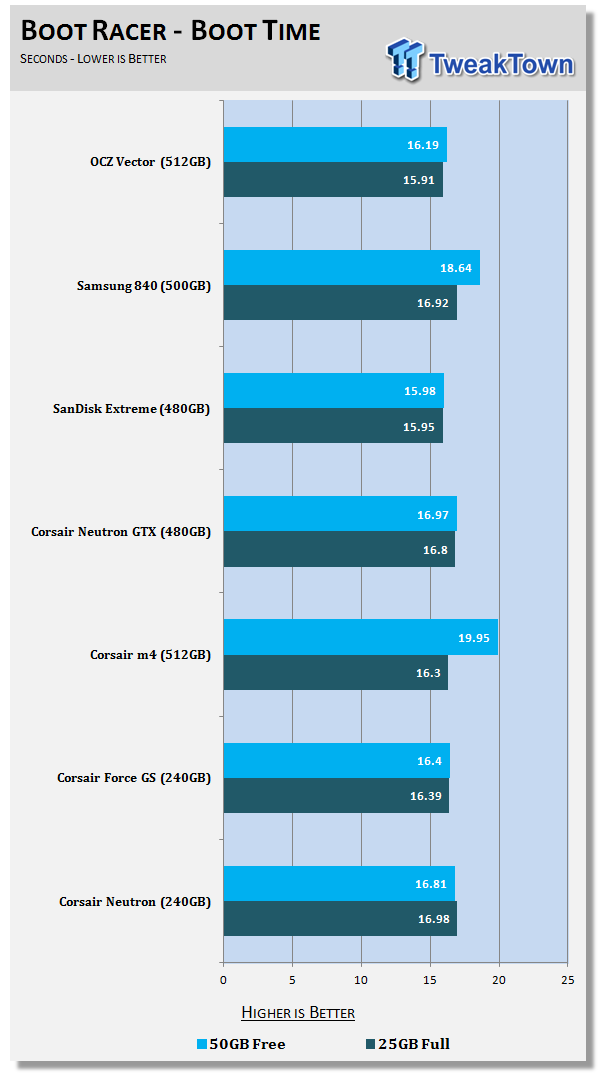
Performance is still lost when Vector 512GB has data on it and it scales as more data resides on the drive. Here we see the boot time with the OS, Office and a few test programs installed. Then again, with the drive filled to only 50GB available. The boot time difference is less than 1 second.
Benchmarks - DiskBench
DiskBench - Directory Copy
Version and / or Patch Used: 2.6.2.0
Developer Homepage: Nodesoft
Product Homepage: DiskBench
Download here: http://www.nodesoft.com/diskbench/download
Note: In this test we use the Lenovo W530 Mobile Workstation and a SuperSSpeed S301 SLC 128GB SSD to move a 15GB block of data to and from the target drive. This is part of our real world test regiment. Roughly 45GB of data resides on the target drive before the '15GB Block' is transfer. The 15GB Block is the same data we built for the Data on Disk Testing and is a mix of compressible and incompressible data.
Directory Copy
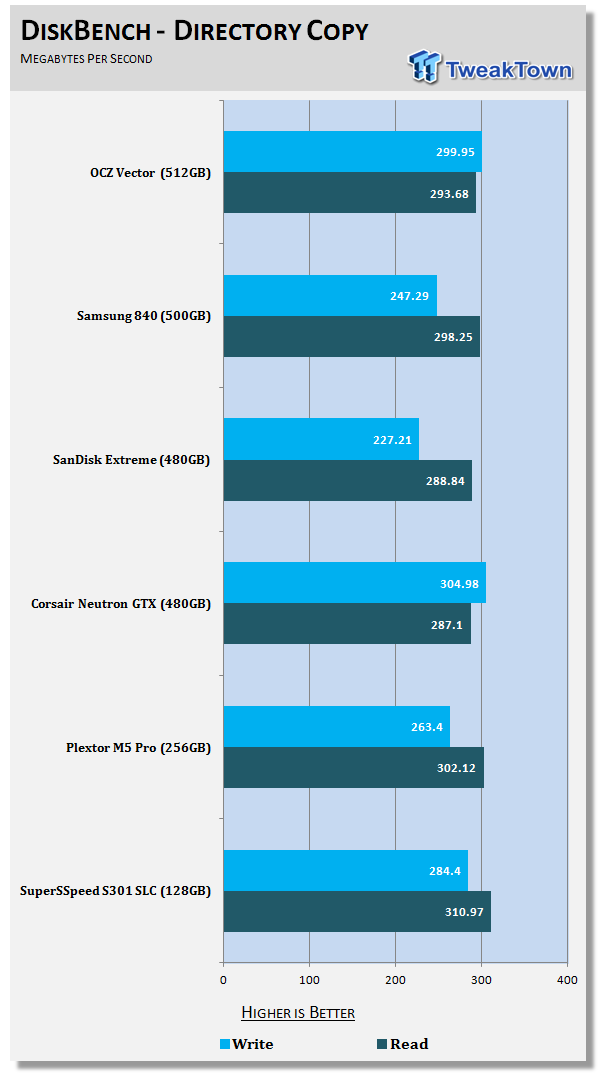
When filling the drive we use DiskBench to record how long it takes to write one 15GB block of data to the drive and when reading it back from the drive as well. OCZ increased the single queue depth read performance over Vertex 4 and that limit is now outside of what you would see when actually transferring files.
Benchmarks - Power Testing
Bapco MobileMark 2012 1.5
Version and / or Patch Used: 2012 1.5
Developer Homepage: http://www.bapco.com
Test Homepage: http://www.bapco.com
MobileMark 2012 1.5 is an application-based benchmark that reflects usage patterns of business users in the areas of office productivity, media creation and media consumption. Unlike benchmarks that only measure battery life, MobileMark 2012 measures battery life and performance simultaneously, showing how well a system design addresses the inherent tradeoffs between performance and power management.

Vertex 4 was a power vampire, pulling as much power as a WD Scorpio Blue 5,400 RPM 2.5" HDD. Vector reeled the power in quite a bit, but not to the same levels as Samsung or Crucial on the m4.
PCMark Vantage HDD Test - Power Draw

Here we see where all that power goes. Vector has fairly high idle power, but at the same time, power consumption doesn't increase much when reading data from the drive. The random writes give us very high peaks, but only once did this drive pull more power than the others in the test.
Final Thoughts

Just a few months ago we were told OCZ was done for, a goner before the end of the year, but we don't think OCZ is going anywhere now. Sure, there are some good drives on the market from companies with slush funds larger than OCZ's annual sales, but OCZ has proved time and time again that they are the one to beat. After several years leading the 'me too' crowd, OCZ had to rely on common market controllers to build innovative products like the RevoDrive Series. Now they have their own controller and with it they pose a serious threat to companies that once looked at OCZ as a small fish in a very big pond.
That said, this is a critical time for OCZ to make the right moves because what happens now is amplified in the future. We've had innovators in the computer market before fizzle out after making poor decisions - ABIT and DFI come to mind because they too were on the bleeding edge. In their final days, those companies chose to expand into other markets with their last breath, but OCZ made the correct choice and consolidated, choosing to focus on what should lead them into the future as a prosperous company, high-end solid state products.
As we stated early in the review, we don't expect OCZ to lower the prices on Vector anytime soon. Vector has a nice performance lead over everything else on the market including the Samsung 840 Pro (review coming just days after this one). Baring a CES surprise, Vector looks to lead the performance category all the way to CeBIT and maybe even as far as Computex. My glass ball is hazy beyond Computex and the Magic 8-Ball is only for market analysts that claimed OCZ was finished for good.
Still, the Vector 512GB has an awfully high price point right now, costing as much as a notebook on Wal-Mart special. I think desktop users running anything newer than a P67 chipset with dual native SATA III would be better off with two 256GB Vector drives and the 1000+ MB/s performance that comes with them. Notebook and ultrabook users on the other hand don't have the luxury of RAID and that's where Vector 512GB really has to be taken seriously. The 7mm z-height means Vector will fit your ultrabook and the power consumption isn't as bad as Vertex 4. After running Vector next to a Samsung 840 Pro in identical Lenovo w530 notebooks, I can tell you that Vector is faster in real world tasks when writing data. When reading data the two are very close, nearly identical. The power consumption nod goes to Samsung though, but not by a large margin. The 840 Pro uses more power than the vanilla 840 with TLC flash.
The more I play with Vector on my own time and explore the features the more I understand why the drive is programmed the way it is. The limited single request read performance used to annoy me when testing, but after using the drives, even Vertex 4, I've learned that is the secret sauce for why both of these drives feel faster than the benchmark results show. At that point I would have to say that Vector is like a workstation computer with multi processors. You can tackle more tasks at the same time without feeling like you have intensive apps running. The difference between what OCZ did with this drive and older SSDs is like moving from a single core computer to your first dual core computer. I know that comparison goes back a few years, but it's the best way to describe what's going on. Just like when dual core and SMP systems hit the consumer market, we really don't have benchmark software to really show the real performance increases. You just have to take one for a spin to understand it.

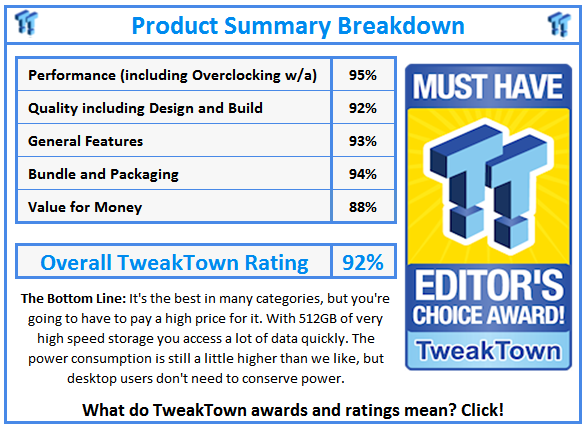
 United
States: Find other tech and computer products like this
over at
United
States: Find other tech and computer products like this
over at  United
Kingdom: Find other tech and computer products like this
over at
United
Kingdom: Find other tech and computer products like this
over at  Australia:
Find other tech and computer products like this over at
Australia:
Find other tech and computer products like this over at  Canada:
Find other tech and computer products like this over at
Canada:
Find other tech and computer products like this over at  Deutschland:
Finde andere Technik- und Computerprodukte wie dieses auf
Deutschland:
Finde andere Technik- und Computerprodukte wie dieses auf